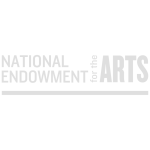LOOK AND LEARN
Put a group of people down in front of a piece of art and you can get a variety of reactions. One person may be moved by the beauty of a piece, while another doesn’t see that at all. Some may feel confident that they know what’s “going on” with the art — what it “‘means,” what it’s “about” — but others may be baffled or even intimidated.
RESOURCES
Our responses to art are very personal, and that’s just as it should be. A little information, however, can help make encounters with art more enjoyable and rewarding. This page offers some guidance to help people appreciate the art offered by the Newport News Public Art Foundation. It can be a resource for parents who want to expose their children to art, for adults trying to figure out what that thing is that appeared alongside a street near them, or for teachers preparing their classes for a field trip.

![]()
Walking Tour: Riverside and CNU
Enjoy a 2-mile, round trip walk to enjoy three of our sculptures, more art, the new pedestrian/bike trail and the Christopher Newport University campus.
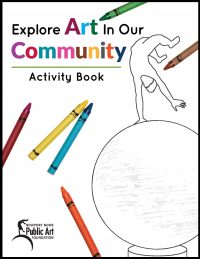
New Activity Book
Our new activity book is a wonderful way to learn about some of the sculptures in our collection, with fun art activities on every page. Get the NNPAF Activity Book and have fun creating!
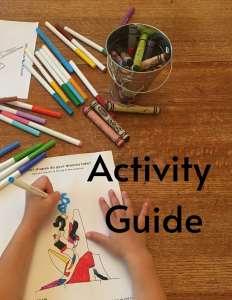
Activity Guide
For even more art activities based on the book, like making a Mobius strip or creating a paper tiger, click on the activity guide photo.
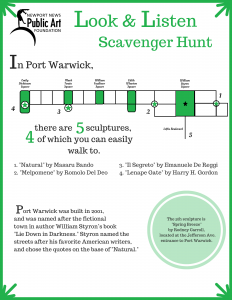
Scavenger Hunt in Port Warwick
Go on our Port Warwick scavenger hunt! A walkable hunt in a beautiful neighborhood. Look closely at four sculptures and use our audio tour (available through the website or as a free app) to listen and learn more about the public art in this neighborhood.
ASK YOURSELF SOME QUESTIONS
One of the best ways into art is to ask yourself some questions.
What is the first thing I noticed? And what is the 10th thing?
These questions encourage us to do two things: to let ourselves respond instinctively to art first, and then to look more closely. When we stop to really look at something, to see details and layers that didn’t appear at first glance, we discover real meaning and pleasure in art.
Maybe the first thing you notice about Carambola is the figure balanced on top. But look closer and you notice other things, like the suggestion that the sphere is ready to roll and the sense that the figure is poised to move in response.
Look at Reinvented, and the first thing that registers may be the donut shape. A closer look will bring your eye to the polished surface and the twist in the shape, things of beauty you would miss if you did not take the time to see them.
Does it look different from different angles? What happens when the light changes?
A work of art may have more to offer than what you see head-on or during the day. Move around the art and look at the back and sides. Come back at night and see what it looks like lit up. A lot of care goes into designing the lighting for sculpture — look at what it does. Does it add drama? What features does it illuminate?
What is the subject of this piece?
This may be perfectly obvious — or not. There are two parts to this question: “What do you think the artist’s idea of the subject is?” and “What do you think the subject is?” Yes, you get to have a say in what a sculpture is about … for you.
Abstract works can be challenging. People try to find figurative elements in them — “Is that a dragon?” — when the artist was trying to express emotions or ideas, not depict anything tangible. For example, Richard Hunt gives us clues to the subject of his abstract expressionist work Build a Dream in its title and in the piece itself. The base is strong and stable with steps that climb. Above it are sweeping forms, becoming increasingly complex and beautiful as they reach higher. It suggests that if we build on a solid foundation we can accomplish amazing things. That prompts the question: What are the building blocks of dreams attained? That is a question each of us has to answer for ourselves.
What adjectives come to the tip of your tongue when you look at this piece?
Then probe a little deeper and ask yourself: What makes that word come to mind?
Play “I spy” if you’re with another person — children love this game.
Find a detail, give the other person a hint, and let them guess what you saw. To play this game, you will have to look closely at a work of art, which means you’re more likely to see things that please or intrigue or inspire you.
For example, “I spy, with my little eye, something leaning “ on Izar will direct your eyes to the incline of the vertical planes, and then you’ll notice that the piece is conceived as one piece of metal, slit into three parts and gently twisted around a central axis. With Spirit of Life, “I spy something ruffled” will direct your eye to the fine — yes, ruffled marble — edges.
How do I feel about this piece? Do I like it? If yes, why? What does it have in common with other things I like? And if I don’t like it, why not, and how is it different from things I do like?
Art can help us discover things about ourselves as well as about the world and what artists want to say about it. By stopping to consider how we respond to art, and how we respond differently to different pieces, we learn something about what pleases us, about our outlook on life, about our comfort zone and how happy we are venturing outside it. There is no right or wrong way to respond to art, but it can be illuminating to understand our response.
If I had to tell a story based on this piece of art, what would it be?
Let your imagination go. You have to look carefully at art, and let yourself respond to it, in order to connect it to a story line. The process means you’re connecting with the art.
This can be particularly effective at helping children respond to art. They love stories, and being encouraged to look carefully at a work of art and make up a story can build their powers of observation and of creativity.
What is the artist trying to say?
It can help to find out, straight from the artist, what he or she was trying to say about the world, about life, about how they see things. Go to “Sculptures” on this website and you will find information about each piece in the collection of the Newport News Public Art Foundation with a link to short audio messages in which the artists tell you about their work.
Some of their messages may surprise you and make you take a second look. For example, Rodney Carroll says that Spring Breeze is about relationships, about how we come together and are separated. Would you have seen that without his explanation? Masaru Bando says that Memory of Green is about his childhood experience of feeling enveloped by a tender, strong embrace when springtime’s warmth returned after the harsh winters of his Japanese home. Can you see that story line in this mass of bronze?
Are there symbols?
Decoding symbols can be fun. Are there things in the sculpture that seem to stand for something? For example, Emanuele De Reggi says that the fish the figure in Il Segreto is holding behind his back stands for the truth. Fish also suggest to De Reggi the human mind, for both are constantly in motion, even when we — or the fish — are sleeping.
How does this piece fit its site?
Sculptors care a great deal about the environment in which their pieces appear. That’s why the Newport News Public Art Foundation brings the artist to town to spend time in the community and at the site, so they can create a piece specifically for it.
Ask yourself: Is this a place people drive by? If so, what does that dictate about the piece (hint: look for strong, clean lines that can be taken in quickly)? Is this an intimate setting, where people come close to the art? What about the piece requires that — is it the details, the complexity, the subject? How does what goes on at the site dictate the piece? Consider Helaine Blumenfeld’s message about life unfolding in her Spirit of Life, which is at the entrance to a hospital.
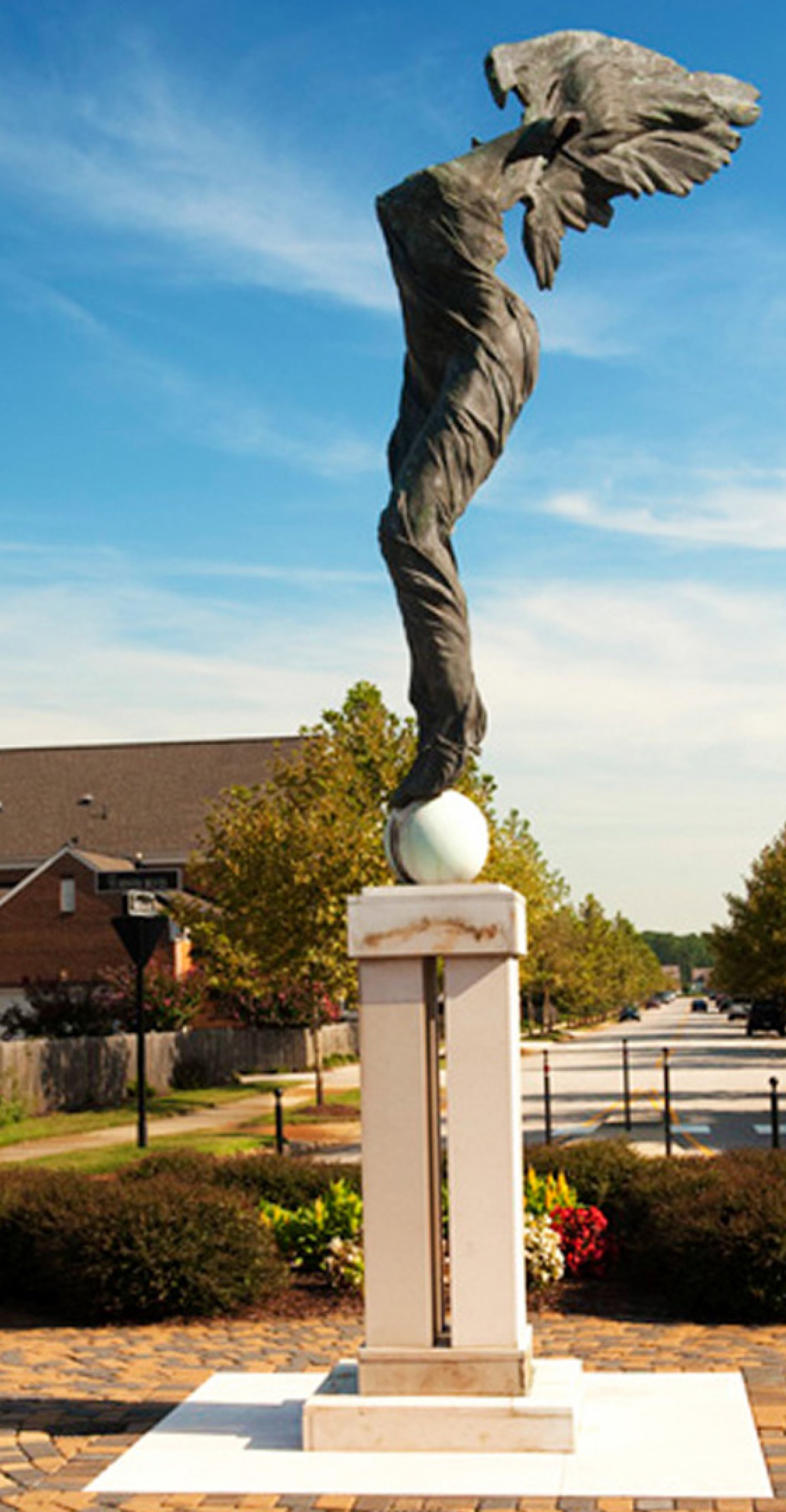
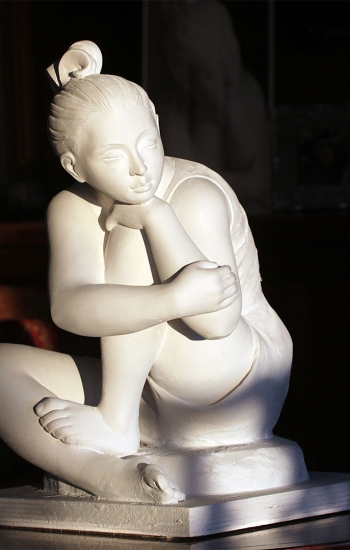
Learn More
Want to look closer? There are plenty of resources to help develop the ability to find pleasure and meaning in art. Here are a few — and we encourage you to share others you enjoy (just contact us by clicking here):
Look! Zoom in on Art by art educator Gillian Wolfe uses engaging questions and well-chosen paintings to teach children to really look at art.
Richard Mulhberger’s series about artists teaches children to look at art. They include What Makes a Monet a Monet?, What Makes a Picasso a Picasso? and What Makes a Van Gogh a Van Gogh?
Looking at Photographs: 100 Pictures from the Collection of The Museum of Modern Art by John Szarkowski examines a different area of art — photography — but as a tool for opening eyes, it is marvelous and worth spending time with for the pictures alone.
Many art galleries and museums offer guided tours and classes. In Newport News, the Mary M. Torggler Fine Arts Center at CNU is a good place to begin. In nearby Hampton, the Charles Taylor Art Center is a great resource.
SUPPORT PUBLIC ART
ART EVERY DAY FOR EVERYONE
We’re all about bringing the finest public art to the City of Newport News that educates, transforms, and inspires our community… and we’re looking to you for help.



